
©2025 Castle Biosciences 1 Empowering people, informing care decisions May 2025
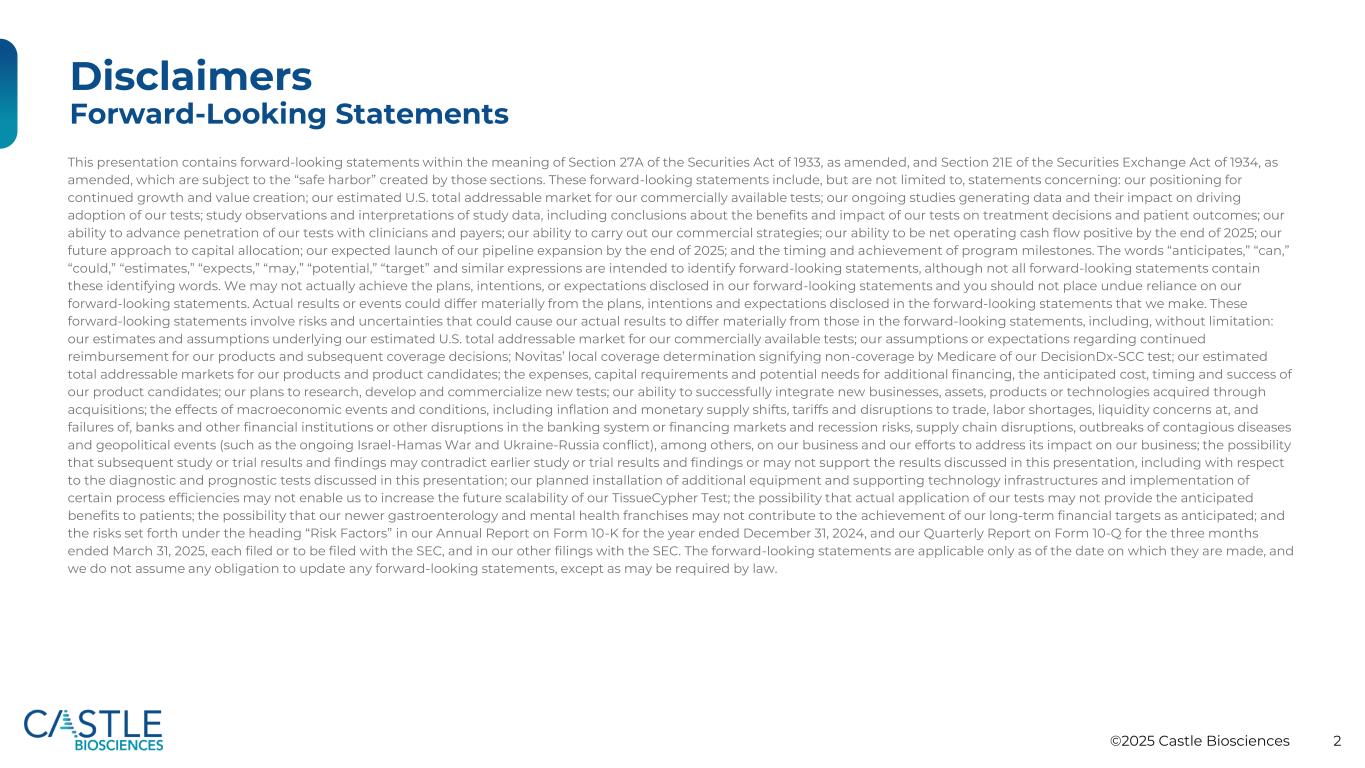
©2025 Castle Biosciences 2 Disclaimers Forward-Looking Statements This presentation contains forward-looking statements within the meaning of Section 27A of the Securities Act of 1933, as amended, and Section 21E of the Securities Exchange Act of 1934, as amended, which are subject to the “safe harbor” created by those sections. These forward-looking statements include, but are not limited to, statements concerning: our positioning for continued growth and value creation; our estimated U.S. total addressable market for our commercially available tests; our ongoing studies generating data and their impact on driving adoption of our tests; study observations and interpretations of study data, including conclusions about the benefits and impact of our tests on treatment decisions and patient outcomes; our ability to advance penetration of our tests with clinicians and payers; our ability to carry out our commercial strategies; our ability to be net operating cash flow positive by the end of 2025; our future approach to capital allocation; our expected launch of our pipeline expansion by the end of 2025; and the timing and achievement of program milestones. The words “anticipates,” “can,” “could,” “estimates,” “expects,” “may,” “potential,” “target” and similar expressions are intended to identify forward-looking statements, although not all forward-looking statements contain these identifying words. We may not actually achieve the plans, intentions, or expectations disclosed in our forward-looking statements and you should not place undue reliance on our forward-looking statements. Actual results or events could differ materially from the plans, intentions and expectations disclosed in the forward-looking statements that we make. These forward-looking statements involve risks and uncertainties that could cause our actual results to differ materially from those in the forward-looking statements, including, without limitation: our estimates and assumptions underlying our estimated U.S. total addressable market for our commercially available tests; our assumptions or expectations regarding continued reimbursement for our products and subsequent coverage decisions; Novitas’ local coverage determination signifying non-coverage by Medicare of our DecisionDx-SCC test; our estimated total addressable markets for our products and product candidates; the expenses, capital requirements and potential needs for additional financing, the anticipated cost, timing and success of our product candidates; our plans to research, develop and commercialize new tests; our ability to successfully integrate new businesses, assets, products or technologies acquired through acquisitions; the effects of macroeconomic events and conditions, including inflation and monetary supply shifts, tariffs and disruptions to trade, labor shortages, liquidity concerns at, and failures of, banks and other financial institutions or other disruptions in the banking system or financing markets and recession risks, supply chain disruptions, outbreaks of contagious diseases and geopolitical events (such as the ongoing Israel-Hamas War and Ukraine-Russia conflict), among others, on our business and our efforts to address its impact on our business; the possibility that subsequent study or trial results and findings may contradict earlier study or trial results and findings or may not support the results discussed in this presentation, including with respect to the diagnostic and prognostic tests discussed in this presentation; our planned installation of additional equipment and supporting technology infrastructures and implementation of certain process efficiencies may not enable us to increase the future scalability of our TissueCypher Test; the possibility that actual application of our tests may not provide the anticipated benefits to patients; the possibility that our newer gastroenterology and mental health franchises may not contribute to the achievement of our long-term financial targets as anticipated; and the risks set forth under the heading “Risk Factors” in our Annual Report on Form 10-K for the year ended December 31, 2024, and our Quarterly Report on Form 10-Q for the three months ended March 31, 2025, each filed or to be filed with the SEC, and in our other filings with the SEC. The forward-looking statements are applicable only as of the date on which they are made, and we do not assume any obligation to update any forward-looking statements, except as may be required by law.

©2025 Castle Biosciences 3 Disclaimers Financial Information; Non-GAAP Financial Measures In this presentation, we use the metrics of Adjusted Revenues, Adjusted Gross Margin and Adjusted EBITDA, which are non-GAAP financial measures and are not calculated in accordance with generally accepted accounting principles in the United States (GAAP). Adjusted Revenues and Adjusted Gross Margin reflect adjustments to GAAP net revenues to exclude net positive and/or net negative revenue adjustments recorded in the current period associated with changes in estimated variable consideration related to test reports delivered in previous periods. Adjusted Gross Margin further excludes acquisition-related intangible asset amortization. Adjusted EBITDA excludes from net income (loss): interest income, interest expense, income tax expense (benefit), depreciation and amortization expense, stock-based compensation expense and change in fair value of trading securities. We use Adjusted Revenues, Adjusted Gross Margin and Adjusted EBITDA internally because we believe these metrics provide useful supplemental information in assessing our revenue and operating performance reported in accordance with GAAP, respectively. We believe that Adjusted Revenues, when used in conjunction with our test report volume information, facilitates investors’ analysis of our current-period revenue performance and average selling price performance by excluding the effects of revenue adjustments related to test reports delivered in prior periods, since these adjustments may not be indicative of the current or future performance of our business. We believe that providing Adjusted Revenues may also help facilitate comparisons to our historical periods. Adjusted Gross Margin is calculated using Adjusted Revenues and therefore excludes the impact of revenue adjustments related to test reports delivered in prior periods, which we believe is useful to investors as described above. We further exclude acquisition-related intangible asset amortization in the calculation of Adjusted Gross Margin. We believe that excluding acquisition-related intangible asset amortization may facilitate gross margin comparisons to historical periods and may be useful in assessing current-period performance without regard to the historical accounting valuations of intangible assets, which are applicable only to tests we acquired rather than internally developed. We believe Adjusted EBITDA may enhance an evaluation of our operating performance because it excludes the impact of prior decisions made about capital investment, financing, investing and certain expenses we believe are not indicative of our ongoing performance. However, these non-GAAP financial measures may be different from non-GAAP financial measures used by other companies, even when the same or similarly titled terms are used to identify such measures, limiting their usefulness for comparative purposes. These non-GAAP financial measures are not meant to be considered in isolation or used as substitutes for net revenues, gross margin, or net income (loss) reported in accordance with GAAP; should be considered in conjunction with our financial information presented in accordance with GAAP; have no standardized meaning prescribed by GAAP; are unaudited; and are not prepared under any comprehensive set of accounting rules or principles. In addition, from time to time in the future, there may be other items that we may exclude for purposes of these non- GAAP financial measures, and we may in the future cease to exclude items that we have historically excluded for purposes of these non-GAAP financial measures. Likewise, we may determine to modify the nature of adjustments to arrive at these non-GAAP financial measures. Because of the non-standardized definitions of non-GAAP financial measures, the non-GAAP financial measure as used by us in this press release and the accompanying reconciliation tables have limits in their usefulness to investors and may be calculated differently from, and therefore may not be directly comparable to, similarly titled measures used by other companies. Accordingly, investors should not place undue reliance on non-GAAP financial measures. Reconciliations of these non-GAAP financial measures to the most directly comparable GAAP financial measures are presented in the tables at the end of this presentation. Industry and Market Data This presentation includes certain information and statistics obtained from third-party sources. The Company has not independently verified the accuracy or completeness of any such third- party information.

©2025 Castle Biosciences 4 Registered Trademarks DecisionDx-Melanoma, DecisionDx-CMSeq, i31-SLNB, i31-ROR, DecisionDx-SCC, MyPath Melanoma, DiffDx- Melanoma, TissueCypher, IDgenetix, DecisionDx-UM, DecisionDx-PRAME and DecisionDx-UMSeq are trademarks of Castle Biosciences, Inc.

©2025 Castle Biosciences 5 Improving health through innovative tests that guide patient care OUR MISSION Transforming disease management by keeping people first: patients, clinicians, employees, and investors OUR VISION

©2025 Castle Biosciences 6 Answering Clinical Questions To Guide Care Along The Patient Journey Our focus is on diagnostic support, risk stratification and therapy selection/response areas of the patient care continuum Dermatology Ophthalmology Gastroenterology Diagnostic Support Risk Stratification Therapy Selection/ Response PATIENT CARE JOURNEY Atopic Dermatitis Pipeline Test

©2025 Castle Biosciences 7 Proven strategy designed to drive value creation for our stakeholders FOCUS on best/first-in-class tests with high, unmet clinical need and significant market opportunity BUILD robust clinical evidence PENETRATE target markets to further test adoption by clinicians and payers

©2025 Castle Biosciences 8 Building evidence showing the value of our tests Data from our prospective, multicenter DECIDE study show use of DecisionDx- Melanoma can significantly reduce unnecessary sentinel lymph node biopsy procedures and importantly, that melanoma patients who forego the surgery based on their low-risk test result have positive outcomes (as of last follow-up, recurrence free survival of 100%; two-year median follow- up)1 Studies2 demonstrating that our test can improve risk stratification when used in conjunction with staging, to help predict responsiveness to adjuvant radiation therapy (ART) and when used in conjunction with clinicopathologic factors in considering use of ART, can potentially lead to net annual Medicare healthcare savings of up to approximately $972 million Ablation has been shown to stop progression to EAC but use is generally limited to clinicopathologically identified higher-risk patients.3 Pooled analysis4 and SRMA studies5 show that our test is a stronger identifier of higher risk disease compared to all clinicopathologic factors BUILD 1. Guenther, JM, et al. Society of Surgical Oncology SSO 2024 Annual Meeting. Ann Surg Oncol 31 (Suppl 1), S32 (2024). Guenther et al. World J. Surg. Oncol. 2025; 2. Arron et al., Wysong A, Newman JG, Covington KR, et al., Gopal R, Marquardt M, Singh G, et al., Somani SK, Ibrahim SF, Tassavor M, et al., and Newman et al. Head & Neck 2021; Ruiz et al. JAAD 2022; Moody et al. accepted and Castle Biosciences data on file; 3. Cotton CC, et al. Gastroenterology. 2017; 4. Davison et al. Clin Transl Gastroenterol 2023; 5. Castle Biosciences data on file (Systematic Review and Meta-Analysis of TissueCypher’s predictive performance in five completed clinical validation studies) EAC=esophageal adenocarcinoma

©2025 Castle Biosciences 9 Individual risk of SLNB positivity Individual risk of recurrence ? 31-GEP Class Score Ulceration Breslow thickness Age Mitotic rate Ulceration Age Breslow thickness Mitotic rate SLN status Tumor location Collaborative study with the National Cancer Institute’s SEER Program Registries is the largest real- world study of GEP testing in melanoma (n=4,687): • SEER cohort of unselected, prospectively tested patients shows improved survival for patients tested with DecisionDx-Melanoma compared to untested patients with 29% lower 3-year melanoma-specific and 17% lower 3-year overall mortality, and • DecisionDx-Melanoma provided significant, independent risk stratification of patients with cutaneous melanoma SLN- patients with a high-risk DecisionDx-Melanoma result had routine imaging surveillance added to their treatment plan. These patients: • Had their recurrence detected ~10 months earlier, with 62% lower tumor burden • Were more likely to start immunotherapy when offered (76.3% vs 67.9%) • Saw improved overall survival outcomes at 45 months (86.8% vs 75%) Whitman et al. JCO PO. 2021; Jarell et al. JAAD. 2022 Bailey et al. 2023; Dhillon et al. 2023 BUILD “Patients who received routine imaging after high- risk GEP test scores had an earlier recurrence diagnosis with lower tumor burden, leading to better clinical outcomes.” Clinical use of DecisionDx-Melanoma is associated with improved patient survival DecisionDx-Melanoma provides precise, personalized risk prediction for two critical clinical questions

©2025 Castle Biosciences 10 DecisionDx-Melanoma significantly improves risk stratification in stage I melanoma compared to AJCC staging DecisionDx-Melanoma was compared to American Joint Committee on Cancer Staging Manual 8th Edition (AJCC8) staging for stage I cutaneous melanoma (CM) patients (n=6,883) in 2 cohorts and analyzed for recurrence-free survival and melanoma-specific survival. Study results demonstrated: • DecisionDx-Melanoma significantly improved patient risk stratification, independent of AJCC8 staging in patients • DecisionDx-Melanoma provided greater separation between high-risk (Class 2B) and low risk (Class 1A) groups than seen between AJCC8 stage IA and IB COHORT 1 – Combined Combined cohort of stage I CM patients enrolled in previous retrospective and prospective studies from multiple centers (n=1,261) Podlipnik, et al. Cancers. 2024 COHORT 2 – NCI-SEER Large, unselected real-world cohort of stage I CM patients from the SEER registry (n=5,651) BUILD

©2025 Castle Biosciences 11 Evidence from prospective studies supporting DecisionDx-Melanoma demonstrates: DecisionDx- Melanoma low-risk, Class 1A patients who forego a SLNB have high recurrence-free survival DecisionDx- Melanoma low-risk test results are associated with low SLNB positive outcomes Physicians are using DecisionDx-Melanoma to inform clinical decisions about sentinel lymph node biopsy (SLNB) and performing fewer SLNBs Guenther, JM, et al. Society of Surgical Oncology SSO 2024 Annual Meeting. Ann Surg Oncol 31 (Suppl 1), S32 (2024). Yamamoto et al. CMRO. 2023. Guenther et al. World J. Surg. Oncol. 2025 1 2 3 BUILD
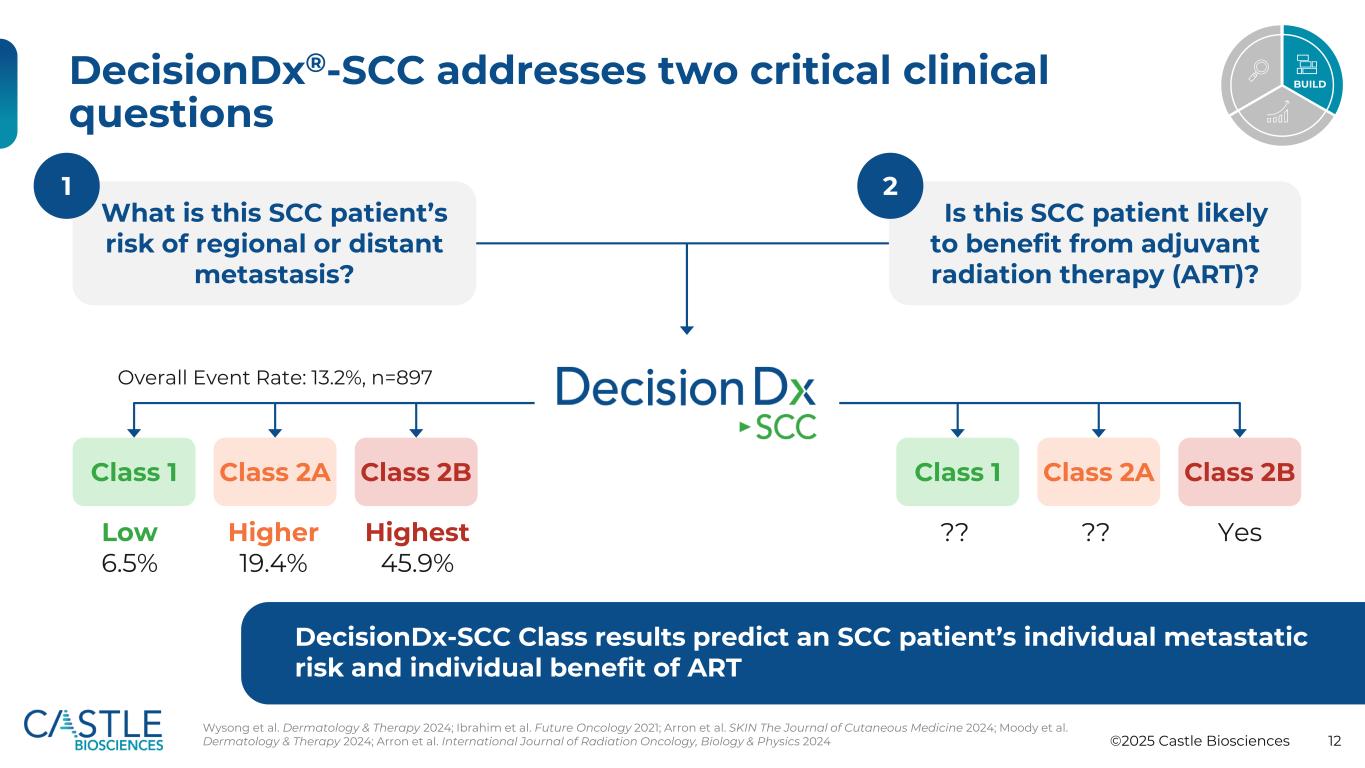
©2025 Castle Biosciences 12 DecisionDx®-SCC addresses two critical clinical questions What is this SCC patient’s risk of regional or distant metastasis? Is this SCC patient likely to benefit from adjuvant radiation therapy (ART)? Class 1 Class 2A Class 2B Low 6.5% Higher 19.4% Highest 45.9% ?? ?? Yes Class 1 Class 2A Class 2B Overall Event Rate: 13.2%, n=897 1 2 DecisionDx-SCC Class results predict an SCC patient’s individual metastatic risk and individual benefit of ART Wysong et al. Dermatology & Therapy 2024; Ibrahim et al. Future Oncology 2021; Arron et al. SKIN The Journal of Cutaneous Medicine 2024; Moody et al. Dermatology & Therapy 2024; Arron et al. International Journal of Radiation Oncology, Biology & Physics 2024 BUILD

©2025 Castle Biosciences 13 DecisionDx-SCC identifies patients who benefit most from ART to control metastatic disease progression Arron et al. International Journal of Radiation Oncology, Biology & Physics 2024; Moody et al. Dermatology & Therapy 2024 • A Class 2B result reflects a significant decrease in median risk of metastatic disease progression between resampled cohorts that did and did not receive ART M E D IA N M E T P R O G R E S S R A T E ( % ) TIME (YEARS) 1.00 0.75 0.50 0.25 0.0 0 0 1 2 3 4 5 MEDIAN RISK OF METASTATIC DISEASE PROGRESSION ART: Class 1 noART: Class 1 noART: Class 2A ART: Class 2A ART: Class 2B noART: Class 2B • A Class 1 or Class 2A result did not reflect a significant decrease in median risk of metastatic disease progression between resampled cohorts that did and did not receive ART 100 5 5 BUILD
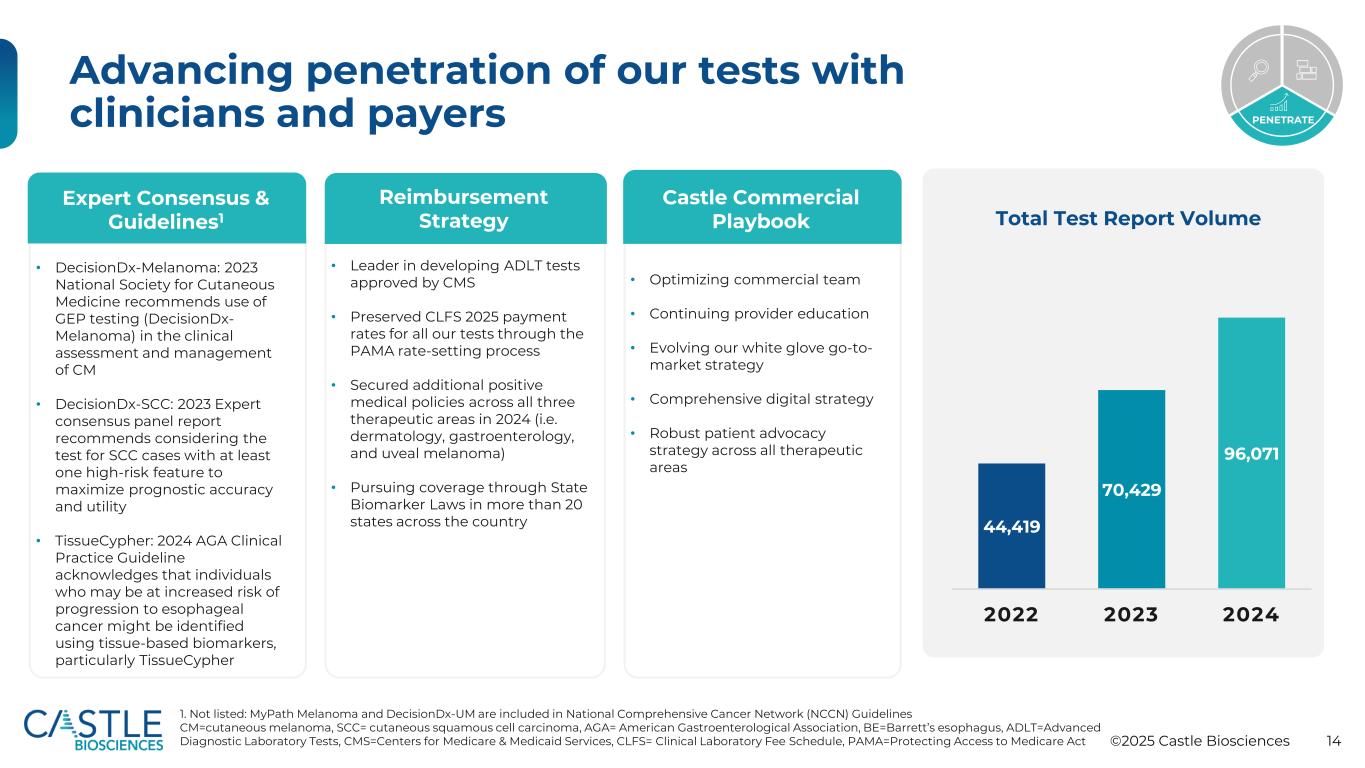
©2025 Castle Biosciences 14 Advancing penetration of our tests with clinicians and payers Expert Consensus & Guidelines1 Reimbursement Strategy Castle Commercial Playbook PENETRATE 1. Not listed: MyPath Melanoma and DecisionDx-UM are included in National Comprehensive Cancer Network (NCCN) Guidelines CM=cutaneous melanoma, SCC= cutaneous squamous cell carcinoma, AGA= American Gastroenterological Association, BE=Barrett’s esophagus, ADLT=Advanced Diagnostic Laboratory Tests, CMS=Centers for Medicare & Medicaid Services, CLFS= Clinical Laboratory Fee Schedule, PAMA=Protecting Access to Medicare Act • DecisionDx-Melanoma: 2023 National Society for Cutaneous Medicine recommends use of GEP testing (DecisionDx- Melanoma) in the clinical assessment and management of CM • DecisionDx-SCC: 2023 Expert consensus panel report recommends considering the test for SCC cases with at least one high-risk feature to maximize prognostic accuracy and utility • TissueCypher: 2024 AGA Clinical Practice Guideline acknowledges that individuals who may be at increased risk of progression to esophageal cancer might be identified using tissue-based biomarkers, particularly TissueCypher • Leader in developing ADLT tests approved by CMS • Preserved CLFS 2025 payment rates for all our tests through the PAMA rate-setting process • Secured additional positive medical policies across all three therapeutic areas in 2024 (i.e. dermatology, gastroenterology, and uveal melanoma) • Pursuing coverage through State Biomarker Laws in more than 20 states across the country • Optimizing commercial team • Continuing provider education • Evolving our white glove go-to- market strategy • Comprehensive digital strategy • Robust patient advocacy strategy across all therapeutic areas 44,419 70,429 96,071 2022 2023 2024 Total Test Report Volume

©2025 Castle Biosciences 15 Financials
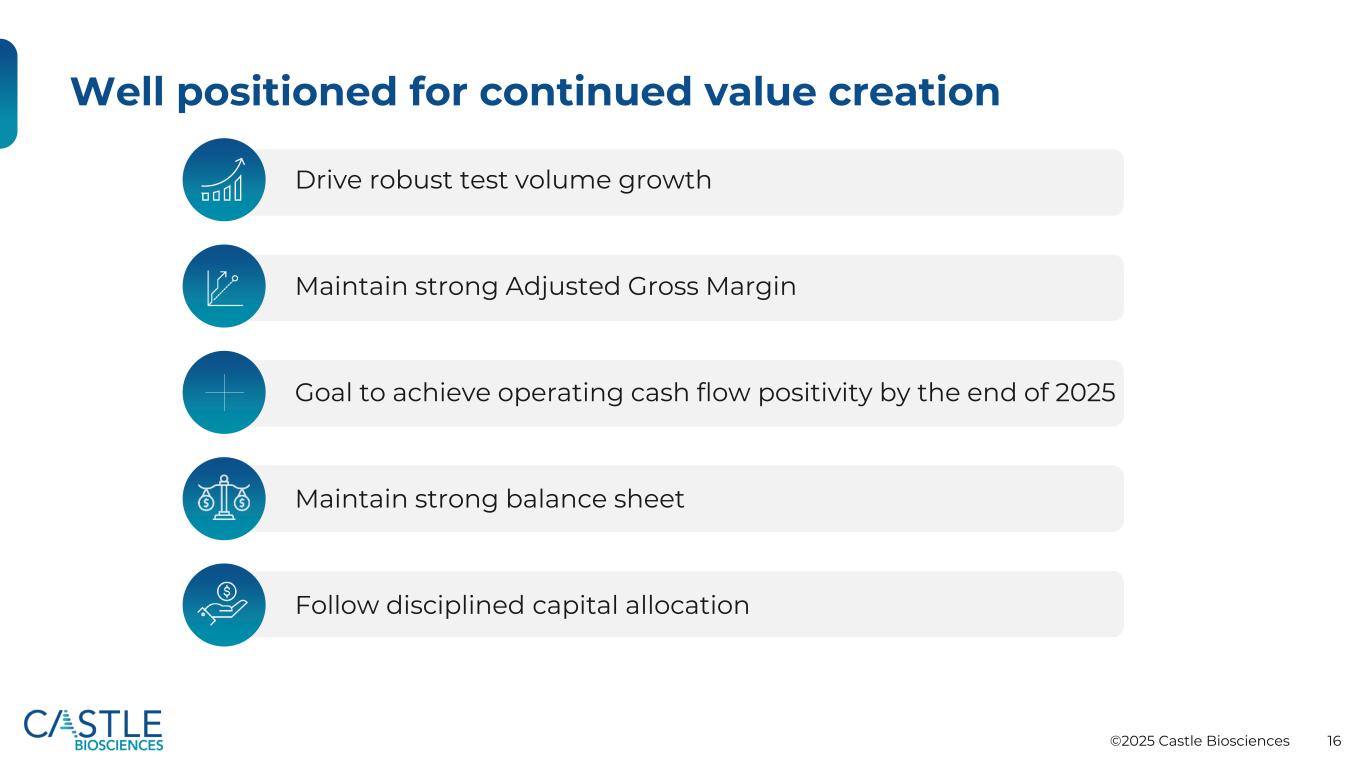
©2025 Castle Biosciences 16 Well positioned for continued value creation Drive robust test volume growth Maintain strong Adjusted Gross Margin Goal to achieve operating cash flow positivity by the end of 2025 Maintain strong balance sheet Follow disciplined capital allocation

©2025 Castle Biosciences 17 Drive robust test report volume and revenue growth $59.3 $68.8 $65.1 $63.8 $63.0 $13.6 $18.2 $20.7 $22.5 $25.0 Q1 2024 Q2 2024 Q3 2024 Q4 2024 Q1 2025 Dermatologic Non-Dermatologic $87.0 $73.0 $85.8 $86.3 $88.0 NET REVENUE BY QUARTER ($M) Q1 2024 Q2 2024 Q3 2024 Q4 2024 Q1 2025 DecisionDx-UM MyPath Melanoma IDgenetix TissueCypher DecisionDx-SCC DecisionDx-Melanoma TOTAL TEST VOLUME BY QUARTER 1. Consists of DecisionDx-Melanoma, DecisionDx-SCC and our Diagnostic Gene Expression Profile offering (MyPath Melanoma and DiffDx-Melanoma) 2. Consists of TissueCypher Barrett’s Esophagus Test, DecisionDx-UM and IDgenetix 3. Q4 2024 DecisionDx-Melanoma volume reflects typical seasonality, with the fourth quarter historically having the fewest workdays compared to the other three quarters, and specifically Q4 2024 had two less working days than Q3 2024; further, the overlap of Christmas and Hanukkah led to additional dermatology practice closures 4. In late 2024, we revised our commercial strategy for our IDgenetix test, reallocating resources to inside sales and non-personal promotions 5. Effective May 2025, IDgenetix will be discontinued 1 2 20,888 25,102 26,010 24,0713,4 5 24,402
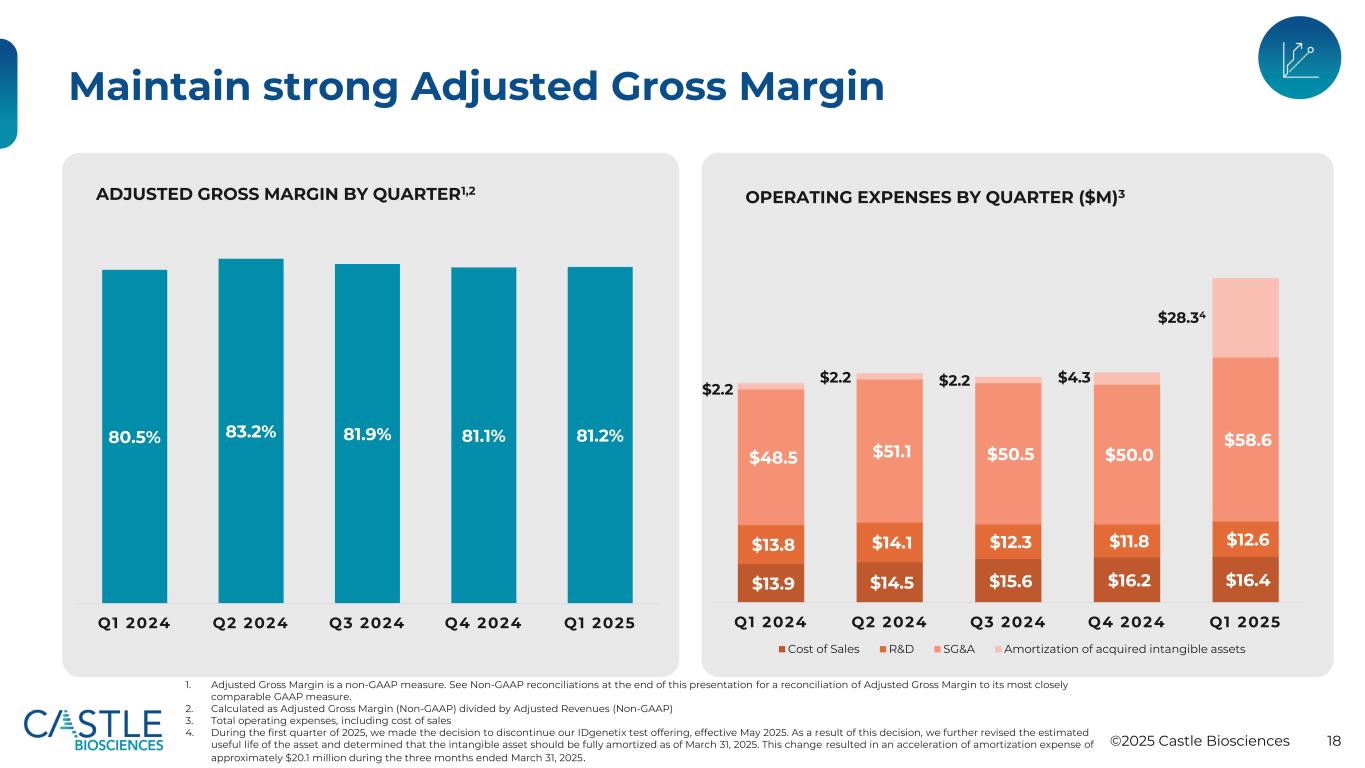
©2025 Castle Biosciences 18 Maintain strong Adjusted Gross Margin 80.5% 83.2% 81.9% 81.1% 81.2% Q1 2024 Q2 2024 Q3 2024 Q4 2024 Q1 2025 ADJUSTED GROSS MARGIN BY QUARTER1,2 $13.9 $14.5 $15.6 $16.2 $16.4 $13.8 $14.1 $12.3 $11.8 $12.6 $48.5 $51.1 $50.5 $50.0 $58.6 $2.2 Q1 2024 Q2 2024 Q3 2024 Q4 2024 Q1 2025 Cost of Sales R&D SG&A Amortization of acquired intangible assets OPERATING EXPENSES BY QUARTER ($M)3 1. Adjusted Gross Margin is a non-GAAP measure. See Non-GAAP reconciliations at the end of this presentation for a reconciliation of Adjusted Gross Margin to its most closely comparable GAAP measure. 2. Calculated as Adjusted Gross Margin (Non-GAAP) divided by Adjusted Revenues (Non-GAAP) 3. Total operating expenses, including cost of sales 4. During the first quarter of 2025, we made the decision to discontinue our IDgenetix test offering, effective May 2025. As a result of this decision, we further revised the estimated useful life of the asset and determined that the intangible asset should be fully amortized as of March 31, 2025. This change resulted in an acceleration of amortization expense of approximately $20.1 million during the three months ended March 31, 2025. $4.3$2.2$2.2 $28.34

©2025 Castle Biosciences 19 Improving operating cash flow and Adjusted EBITDA $(6.8) $24.0 $23.3 $24.4 $(6.0) Q1 2024 Q2 2024 Q3 2024 Q4 2024 Q1 2025 OPERATING CASH FLOW BY QUARTER ($M) 1. As of March 31, 2025; includes Cash, Cash Equivalents & Marketable Investment Securities 2. Net cash used in operating activities in Q1 2025 and Q1 2024 includes payout of annual bonuses as well as certain healthcare benefit contributions 3. Adjusted EBITDA is a non-GAAP measure. See non-GAAP reconciliations at the end of this presentation for a reconciliation of Adjusted EBITDA to its most closely comparable GAAP measure 4. Adjusted EBITDA excludes from net income (loss), interest income, interest expense, income tax expense (benefit), depreciation and amortization expense, stock-based compensation expense and changes in fair value of trading securities $10.5 $21.5 $21.6 $21.3 $13.0 Q1 2024 Q2 2024 Q3 2024 Q4 2024 Q1 2025 ADJUSTED EBITDA BY QUARTER ($M)3,4 Cash position of ~$275M1 supports growth initiatives

©2025 Castle Biosciences 20 A disciplined approach to capital allocation Commercial optimization Focused R&D efforts to build evidentiary support and develop tests As a lesser priority, strategic opportunities, including within our current therapeutic areas

©2025 Castle Biosciences 211 Appendix

©2025 Castle Biosciences 22 DecisionDx-Melanoma DERMATOLOGY Provides comprehensive, personalized, genomic tumor information to guide management for patients with cutaneous melanoma demonstrated change in management for 1 of 2 patients tested3 ~200,000 patients with a clinical DecisionDx- Melanoma order from ~15,000 clinicians4 50% Clinical Validity, Utility and Demonstrated Patient Outcomes Demonstrated clinical validity, utility and impact, backed by 53 peer-reviewed publications, including two publications (Bailey et al. 2023 and Dhillon et al. 2023) demonstrating an association with testing and improved patient outcomes SLNB Guidance and Patient Outcomes1,2 DecisionDx-Melanoma successfully identified patients with T1 tumors with a low risk of SLN positivity who can safely forego SLNB while maintaining high survival rates in a prospective multicenter study and can reduce SLNB- associated complications and healthcare costs. 1. Marks, The i31-GEP identifies patients with T1 cutaneous melanoma who can safely avoid sentinel lymph node biopsy: Results from a prospective, multicenter study. Video abstract presented at: 2024 American Society for Dermatologic Surgery (ASDS) Annual Meeting; 2. Guenther JM, et al. Patients who forego sentinel lymph node biopsy after 31-GEP testing are not harmed: A prospective, multicenter analysis. Poster presented at: 20th European Association of Dermato-Oncology (EADO) Congress; 3. Dillon et al. 2022; 4. Data as of March 31, 2025 ; 5. U.S. TAM = Total addressable market based on estimated patient population assuming average reimbursement rate among all payors. SLN(B)=sentinel lymph node (biopsy) ~$540M Estimated U.S. TAM5

©2025 Castle Biosciences 23 DecisionDx-SCC DERMATOLOGY Identifies the risk of metastasis in patients with squamous cell carcinoma (SCC) and one or more risk factors Clinical Validity and Utility Demonstrated validity, utility and impact, backed by 22 peer-reviewed publications, including data showing that DecisionDx- SCC can significantly impact patient management plans in a risk-appropriate manner within established guidelines Real-World Use Framework Several published studies in 2024 supported the use of DecisionDx-SCC to predict likelihood of benefit from adjuvant radiation therapy (ART); two of these studies represent the largest1 and second largest2 studies completed to date to evaluate the effectiveness of ART in SCC Estimated U.S. TAM4 ~200,000 ~52% ~$820M patients diagnosed annually with SCC and classified as high risk in the U.S. of clinicians ordering DecisionDx-SCC also ordered DecisionDx- Melanoma3 1. Arron et al. International Journal of Radiation Oncology, Biology & Physics 2024; 2. Ruiz et al. Future Oncology 2024; 3. 3-months ended March 31, 2025; 4. U.S. TAM = Total addressable market based on estimated patient population assuming average reimbursement rate among all payors; 5. Somani et al. 2024 net annual Medicare savings that could be realized by using DecisionDx-SCC to guide adjuvant radiation therapy decisions5 Up to ~$972M

©2025 Castle Biosciences 24 MyPath Melanoma DERMATOLOGY Aids in the diagnosis and management for patients with ambiguous melanocytic lesions Clinical Validity and Utility Demonstrated validity, utility and impact, backed by 20 peer-reviewed publications demonstrating the performance and utility of the test in providing objective information to aid in diagnosis in ambiguous melanocytic lesions Guideline Support • National Comprehensive Cancer Network guidelines for cutaneous melanoma in the principles for molecular testing • American Society of Dermatopathology in the Appropriate Use Criteria for ancillary diagnostic testing • American Academy of Dermatology guidelines of care for the management of primary cutaneous melanoma Estimated U.S. TAM2 ~300,000 patients each year present with a diagnostically ambiguous lesion 50,000+ lesions tested clinically1 ~$600M 1. as of March 31, 2025; 2. U.S. TAM = Total addressable market based on estimated patient population assuming average reimbursement rate among all payors.
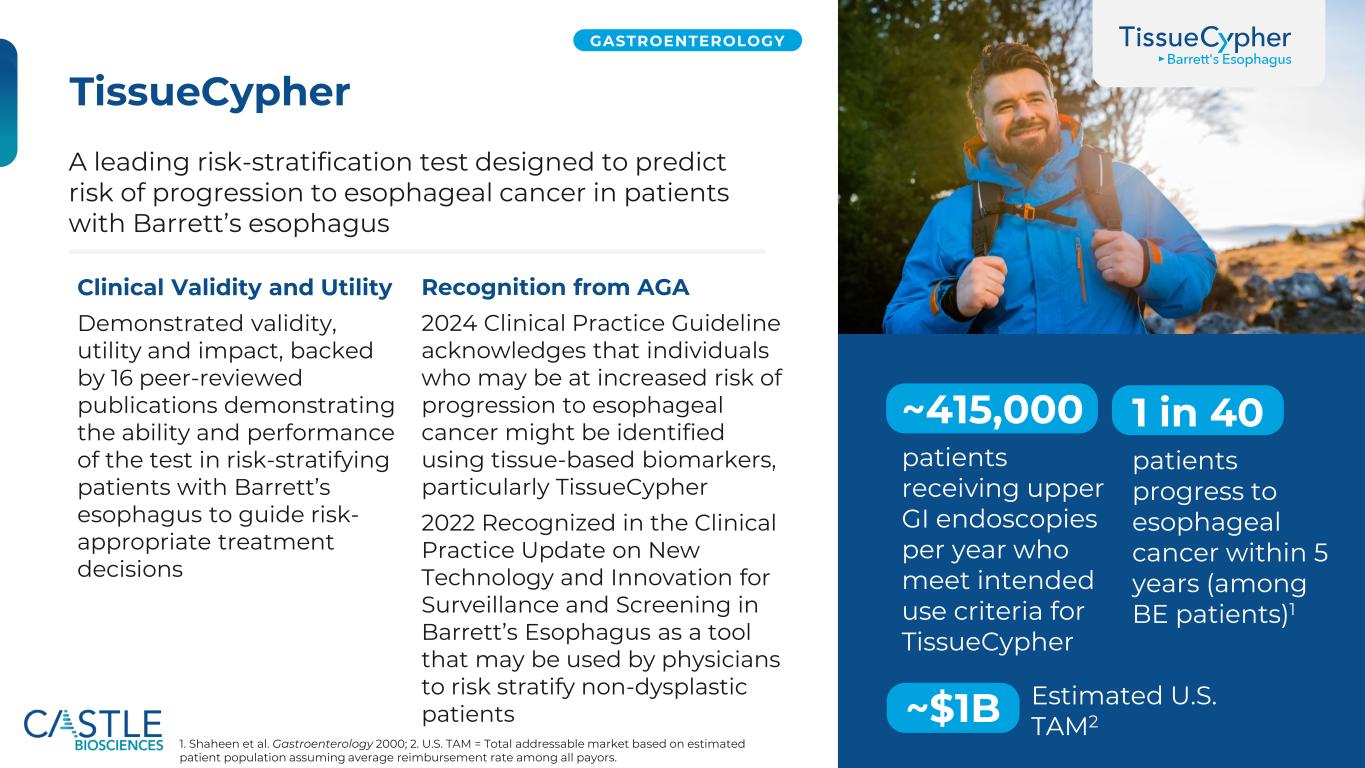
©2025 Castle Biosciences 25 TissueCypher GASTROENTEROLOGY A leading risk-stratification test designed to predict risk of progression to esophageal cancer in patients with Barrett’s esophagus Clinical Validity and Utility Demonstrated validity, utility and impact, backed by 16 peer-reviewed publications demonstrating the ability and performance of the test in risk-stratifying patients with Barrett’s esophagus to guide risk- appropriate treatment decisions Recognition from AGA 2024 Clinical Practice Guideline acknowledges that individuals who may be at increased risk of progression to esophageal cancer might be identified using tissue-based biomarkers, particularly TissueCypher 2022 Recognized in the Clinical Practice Update on New Technology and Innovation for Surveillance and Screening in Barrett’s Esophagus as a tool that may be used by physicians to risk stratify non-dysplastic patients ~415,000 patients receiving upper GI endoscopies per year who meet intended use criteria for TissueCypher 1 in 40 patients progress to esophageal cancer within 5 years (among BE patients)1 ~$1B 1. Shaheen et al. Gastroenterology 2000; 2. U.S. TAM = Total addressable market based on estimated patient population assuming average reimbursement rate among all payors. Estimated U.S. TAM2
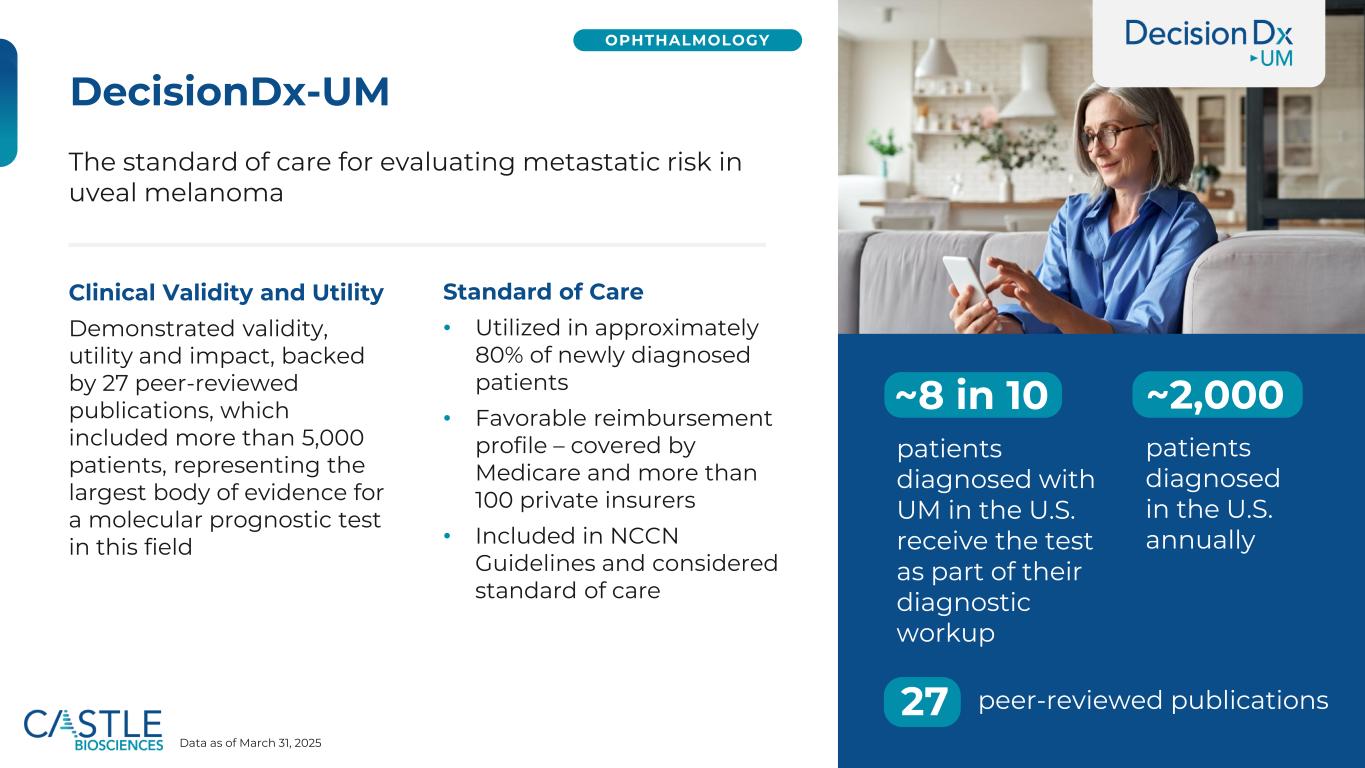
©2025 Castle Biosciences 26 DecisionDx-UM OPHTHALMOLOGY The standard of care for evaluating metastatic risk in uveal melanoma Standard of Care • Utilized in approximately 80% of newly diagnosed patients • Favorable reimbursement profile – covered by Medicare and more than 100 private insurers • Included in NCCN Guidelines and considered standard of care peer-reviewed publications ~8 in 10 ~2,000 27 patients diagnosed in the U.S. annually patients diagnosed with UM in the U.S. receive the test as part of their diagnostic workup Clinical Validity and Utility Demonstrated validity, utility and impact, backed by 27 peer-reviewed publications, which included more than 5,000 patients, representing the largest body of evidence for a molecular prognostic test in this field Data as of March 31, 2025

©2025 Castle Biosciences 27 Atopic Dermatitis Gene Expression Profile Test PIPELINE Test currently in development for use in patients diagnosed with moderate-to-severe atopic dermatitis (AD) who are seeking systemic treatment • Pipeline test has shown potential to identify the class of therapy to which a patient with AD is more likely to respond as indicated by an improvement in Eczema Area and Severity Index (EASI) score • Data from our ongoing validation study for our pipeline test suggests we may be able to improve the standard-of-care ‘trial-and-error’ treatment approach by identifying patients who are more likely to achieve a greater response to a specific class of therapy based on identification of the immune pathway that is driving their AD • Q423: early discovery data presented • Q424: progress update • Assuming successful validation: expect launch by the end of 2025 Past and Anticipated Program Milestones Atopic Dermatitis Pipeline Program
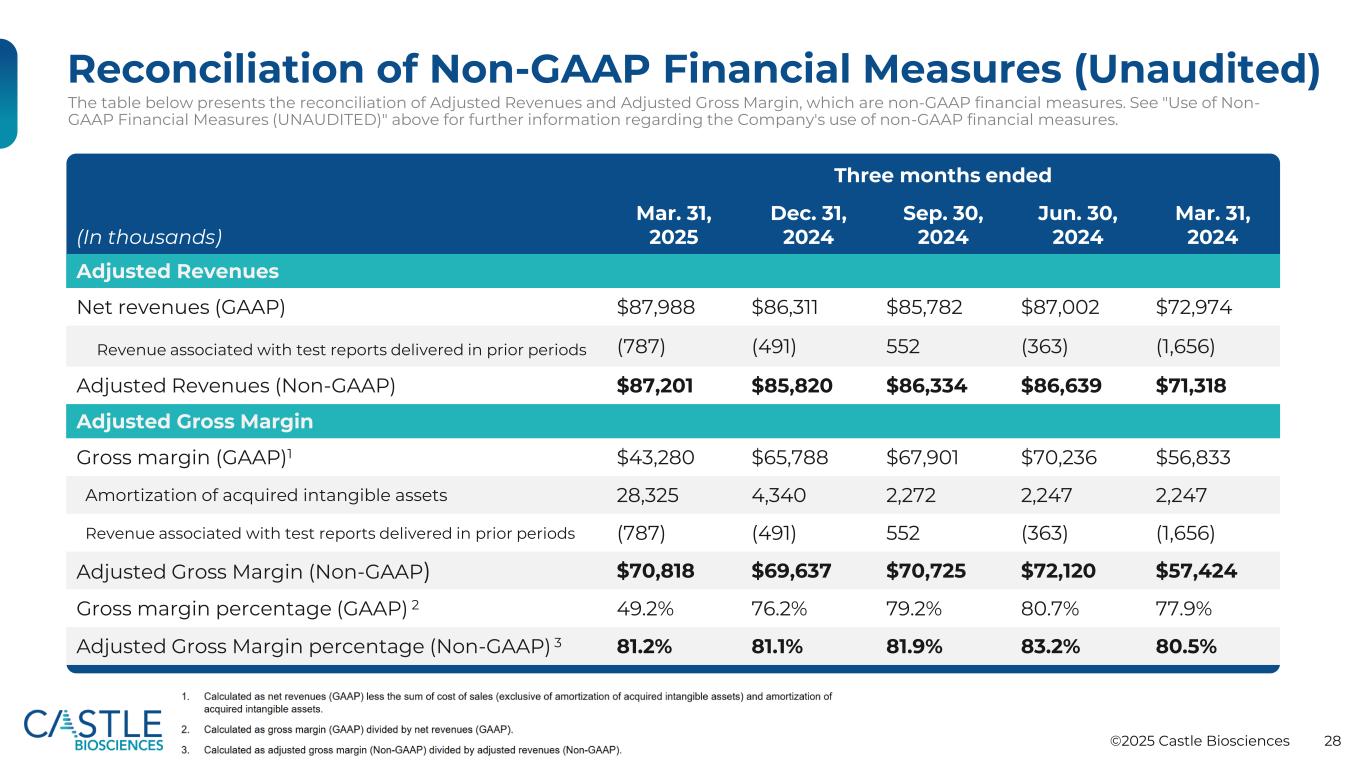
©2025 Castle Biosciences 28 Reconciliation of Non-GAAP Financial Measures (Unaudited) The table below presents the reconciliation of Adjusted Revenues and Adjusted Gross Margin, which are non-GAAP financial measures. See "Use of Non- GAAP Financial Measures (UNAUDITED)" above for further information regarding the Company's use of non-GAAP financial measures. (In thousands) Three months ended Mar. 31, 2025 Dec. 31, 2024 Sep. 30, 2024 Jun. 30, 2024 Mar. 31, 2024 Adjusted Revenues Net revenues (GAAP) $87,988 $86,311 $85,782 $87,002 $72,974 Revenue associated with test reports delivered in prior periods (787) (491) 552 (363) (1,656) Adjusted Revenues (Non-GAAP) $87,201 $85,820 $86,334 $86,639 $71,318 Adjusted Gross Margin Gross margin (GAAP)1 $43,280 $65,788 $67,901 $70,236 $56,833 Amortization of acquired intangible assets 28,325 4,340 2,272 2,247 2,247 Revenue associated with test reports delivered in prior periods (787) (491) 552 (363) (1,656) Adjusted Gross Margin (Non-GAAP) $70,818 $69,637 $70,725 $72,120 $57,424 Gross margin percentage (GAAP) 2 49.2% 76.2% 79.2% 80.7% 77.9% Adjusted Gross Margin percentage (Non-GAAP) 3 81.2% 81.1% 81.9% 83.2% 80.5%

©2025 Castle Biosciences 29 Reconciliation of Non-GAAP Financial Measures (Unaudited) The table below presents the reconciliation of Adjusted EBITDA, which is a non-GAAP financial measure. See "Use of Non-GAAP Financial Measures (UNAUDITED)" above for further information regarding the Company's use of non-GAAP financial measures. (In thousands) Three months ended Mar. 31, 2025 Dec. 31, 2024 Sep. 30, 2024 Jun. 30, 2024 Mar. 31, 2024 Adjusted EBITDA Net income (loss) $(25,848) $9,590 $2,269 $8,920 $(2,534) Interest income (3,099) (3,372) (3,404) (3,144) (2,996) Interest expense 17 92 201 270 14 Income tax (benefit) expense (423) (1,705) 6,013 (1,034) 45 Depreciation and amortization expense 29,764 5,768 3,541 3,348 3,340 Stock-based compensation expense 11,179 11,439 13,027 13,179 12,675 Changes in fair value of trading securities 1,425 (555) — — — Adjusted EBITDA (Non-GAAP) $13,015 $21,257 $21,647 $21,539 $10,544

©2025 Castle Biosciences 30 Thank You